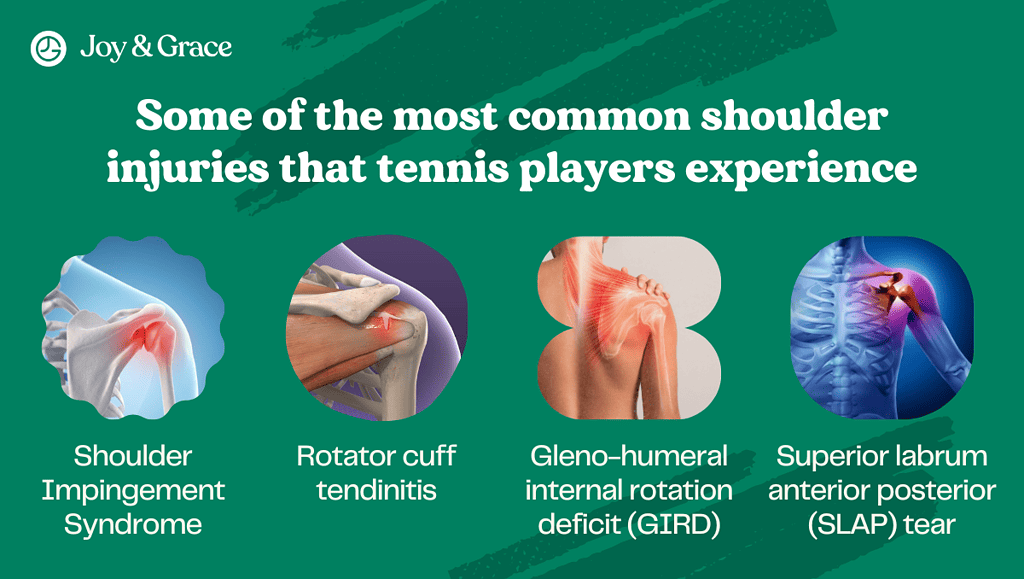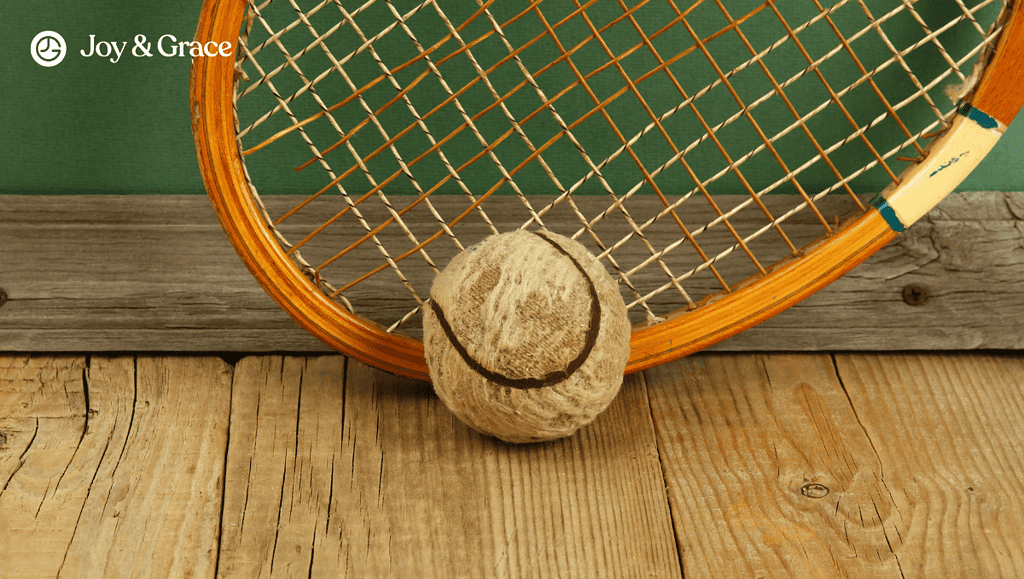If you are a tennis player, you know just how important it is to have a strong and reliable serve. But what do you do when your shoulder begins to hurt with each serve? Through this article, we aim to explain to you the reasons why you may experience shoulder pain when serving and what you can do to get rid of it.
Why Does My Shoulder Hurt From Serving in Tennis?

Almost every tennis player (and tennis fan as well) will agree that a big serve is essential in order to get better at tennis and win matches more quickly. A couple of guys named Sampras and Federer may attest to this!
But practicing your serving requires you to be extra careful. If it is not performed correctly or if it is overdone, serving may damage your shoulders and cause a lot of pain and discomfort. So, how exactly does this damage happen?
First and foremost, it is important to understand that the shoulder is a complex joint made up of:
- Bones
- Muscles
- Tendons, and
- Ligaments
When you serve, you put a lot of strain on your upper body, especially your shoulder joint. If the strain becomes too much to bear or lasts too long, these shoulder parts will eventually experience injury and damage.
The damage that your shoulder experiences is precisely why you may feel shoulder pain after a long day of practicing your serves. Read on as we explain the details.
Shoulder Pain During Forehand Swing
According to the “kinetic chain theory,” different parts of your body, such as your legs, trunk, shoulders, neck, and arms, work together as a chain to produce powerful and effective overhead serving and forehand movements. The shoulder is one of these parts that holds the chain together. If you do not engage your shoulder correctly and adequately, you risk injuring it and feeling pain afterward.
The factors that contribute to shoulder damage and pain from forehand swings and serves include:
- Incorrect technique. Poor technique is a common cause of shoulder issues in tennis. When you use an incorrect technique, like hitting the ball too late, too early, or too low, you put your shoulders under more pressure, which can lead to pain.
- Overuse. Tennis involves repetitive overhead movements that can cause muscle and joint stress, leading to pain. Overplaying without adequate rest can trigger recurring pain.
- Lack of warm-up. A proper warm-up prepares the muscles and joints before starting the main exercise. Skipping a warm-up can make joints and the surrounding tissues more vulnerable and susceptible to injury.
What is the Most Common Shoulder Injury for Tennis Players?

The shoulder area is one of the most frequently injured areas in the body. Shoulder injuries may arise from numerous causes. Below, we have listed some of the most common shoulder injuries that tennis players experience:
- Shoulder Impingement Syndrome and rotator cuff tendinitis and injury. These conditions damage the rotator cuff tendons and muscles. These are responsible for shoulder stabilization and range of motion.
- Gleno-humeral internal rotation deficit (GIRD). A condition in which your shoulder loses some ability to rotate inward.
- Superior labrum anterior posterior (SLAP) tear. An injury to the cartilage ring around the shoulder joint known as the labrum.
Out of all these complicated-sounding conditions, shoulder impingement syndrome is one of the most common injuries in tennis players. It’s a painful type of rotator cuff injury that arises from the inflammation and irritation of the structures within the subacromial space in your shoulder. The subacromial space is the space between the gleno-humeral shoulder joint and the acromion, the topmost bone of the shoulder.
How Long Does Tennis Shoulder Pain Last?
When you experience shoulder pain as a tennis player, one of the first questions that you may immediately think of is, "How long will this pain last?". Unfortunately, there is no straightforward answer to this question.
The time it takes to recover from tennis shoulder pain can vary. Recovery may depend on the extent of the damage, the type of treatment received, and the individual's age and health status.
In a study among young athletes participating in overhead-movement sports (tennis, volleyball, etc.), researchers found that the shoulder pain goes away within 7 to 8 months in about half of the cases. But in some cases, it can continue for years.
The symptoms are often mild. But as an athlete, you may tend to delay seeking medical help anyway because of the pressure to continue playing.
This is why we advise you to seek medical attention immediately upon experiencing shoulder pain while serving and playing tennis. A doctor or physical therapist will perform an evaluation to:
- Assess the root cause of the pain,
- Provide a specific diagnosis, and
- Develop a personalized treatment plan for you.
Can Tennis Serve Cause Neck Pain?

A shoulder injury is not the only type of upper-extremity injury that tennis players may have to go through. The neck, elbows, and knees are other common vulnerable sites affected when serving and playing tennis.
The repetitive and forceful actions of serving can lead to muscle strain and tension in the neck area, causing discomfort and pain.
Similarly, as in shoulder pain, poor technique is one of the frequent reasons why serving also causes neck pain. Players who do not follow proper form when serving may put unnecessary stress on their necks, leading to strain and pain. Improving your serve technique by working with a coach or trainer can prevent neck injuries and pain.
Moreover, tennis serves can cause neck pain due to intense overuse. Players who serve frequently and intensely may develop tension in their neck muscles, which can then lead to pain.
Worn-out equipment, such as tennis rackets, can also cause neck pain during serving. An old or inappropriate racket can lead to an uncomfortable grip, which can then result in poor technique and strain on the neck.
So, what can you do to get rid of the pain quickly and recover in time for those awesome afternoon tennis sessions? Let’s talk about some of the best treatment options for shoulder pain from serving.
How Do I Stop My Shoulders From Hurting When Serving in Tennis?
You have injured your shoulder while serving, and now you feel pain. So you might naturally wonder where your road to full recovery starts. We present below some of the best and most helpful treatment tips that can get rid of your shoulder pain. These tips can help you recover quickly and storm the courts with jaw-dropping aces!
Warm Up Before Playing
It's crucial to warm up before playing tennis to prevent injuries and shoulder pain. According to a 2010 study, warming up before playing was shown to improve performance in as much as 79% of the exercises examined.
Start by stretching your shoulders and arms. After properly stretching, feel free to perform some light cardio to increase blood flow and loosen up your shoulder muscles. Some of the recommended physical activities before playing include:
- Jogging
- Performing jumping jacks
- Rowing at a steady pace
- Cycling at a casual pace
Focus on Your Technique

When serving, make sure to keep your shoulder blades down, engage your abs, and use your legs and hips to generate power. Also, avoid overreaching and pushing through the serve with your arm, which can strain your shoulder and lead to pain.
These steps make sure that the “kinetic chain” we mentioned earlier functions correctly and efficiently, preventing injury.
Strengthen Your Shoulders
Strength training is an excellent way to prevent shoulder pain in tennis players. In this way, you can:
- Increase the stability of your shoulder blade
- Strengthen your rotator cuff muscles, and
- Promote healthy and safe shoulder rotation.
We recommend incorporating various shoulder exercises into your fitness routine to help strengthen the muscles in your shoulders and prevent injury. You may try:
- Lateral raises, by lifting a pair of dumbbells away from your body in an external rotation,
- Front raises, by lifting a pair of dumbbells in front of the body to eye level
- Shoulder presses, by pressing a weight overhead while standing or sitting.
Keep in mind to carefully perform these exercises so as not to add to your injury.
Use Proper Equipment
Using the proper equipment can also help prevent shoulder pain when playing tennis. Make sure your racket is the correct one for you, and consider using vibration damper strings to help reduce the impact on your shoulders.
So, how do you pick the right racket for you? Well, first, you need to find one that fits your personality. It is your very own racket, after all! Here is a mini-guide on what you should consider when picking your (winning) racket:
Take Breaks and Rest
If you're experiencing shoulder pain, taking a break and resting your shoulder is essential. Applying ice to the affected area for 10–20 minutes is also a good idea, as it can help reduce pain and swelling.
You should consider consulting a healthcare professional for further treatment options, such as physical therapy or pain-relieving medication.
Takeaway
Playing tennis, especially serving, puts a lot of strain on your shoulder joint. If the strain becomes too much to bear or if it lasts too long, the shoulder will experience injury and damage and will become painful.
The factors contributing to shoulder damage and pain when serving include:
- An incorrect technique
- Overuse, and
- A lack of warm-up.
Shoulder impingement syndrome is the most common type of shoulder injury when serving in tennis.
Apart from the shoulder, the neck, elbows, and knees are other common vulnerable sites affected when serving.
In order to ease shoulder pain when serving in tennis and promote recovery, you should:
- Warm up before playing
- Focus on your serving technique
- Strengthen your shoulder with strength exercises
- Use proper tennis equipment, and
- Rest adequately.















